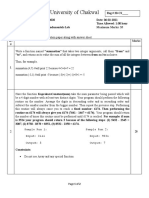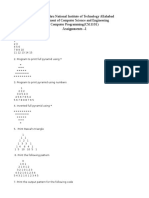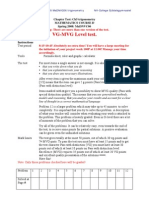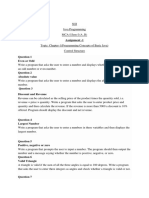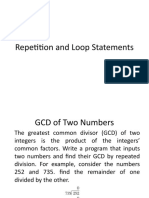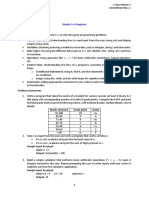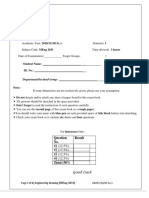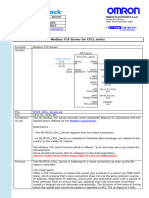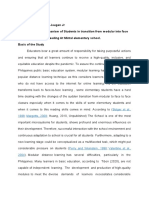CS 123 I2P Assignment 2
CS 123 I2P Assignment 2
Uploaded by
Hafiz AbdullahCopyright:
Available Formats
CS 123 I2P Assignment 2
CS 123 I2P Assignment 2
Uploaded by
Hafiz AbdullahOriginal Title
Copyright
Available Formats
Share this document
Did you find this document useful?
Is this content inappropriate?
Copyright:
Available Formats
CS 123 I2P Assignment 2
CS 123 I2P Assignment 2
Uploaded by
Hafiz AbdullahCopyright:
Available Formats
CS - 123 GIFT University Gujranwala
Course: Introduction to Programming (Spring 2021)
Resource Person: Dr. Muhammad Faheem Assignment–2
Total Points: 20 Submission Due: 06, Sep, 2021
Name: _____________________________ Roll Number: _______________________
Instructions: Please Read Carefully!
This is an individual homework. Everyone is expected to complete the given assignment on his
own, without seeking any help from any website or any other individual. There will be strict
penalties for any work found copied from any source and the university policy on plagiarism will be
strictly enforced.
• You are expected to submit this homework as on Google Classroom.
• You may download the document, print it, solve it and then submit it as captured pictured at Google
Classroom.
• Any homework submission not following the above directions will not be accepted!
• No late submissions will be accepted!
CS-123 Homework-2 Page 1
CS - 123 GIFT University Gujranwala
Question-1 [10 Points]
Write a program that prompts the user for an integer and then prints out all coward numbers up to
that integer. For example, when the user enters 20, the program should print: 3 4 6 8 12 14 18 20.
Recall that a number is a prime number if it is not divisible by any number except 1 and itself.
Hint: Use Nested Loop to solve this problem. Outer Loop iterations must start from 3 and ideally inner
loop iterations must start from 2.
Coward Number: Number whose previous number is not divisible by any number other than 1
and number itself.
Instructions:
1. Create a program called CowardNumbers.java.
2. Create appropriate variables and assign values using a Scanner object.
3. Correctly display appropriate messages.
4. Use Correct Indentation.
5. Submit .java file only.
Question-2 [10 Points]
Write a program that asks the user to enter three positive integer value; number, start, end and
Silicon Value, and then prints the Silicon table of the number from the starting number to the ending
number. After printing the table, our program should ask the user whether he or she wishes to perform
the operation again. If so, the loop should repeat; otherwise it should terminate.
Use a character input of y or Y to repeat, and n and N to terminate the loop. No break statement is
allowed.
NOTE: Perform input validation so that all numbers must be greater than 0 and the “start” number
should be less than “end” number.
NOTE: Silicon Number is multiplied with iteration counter as shown in the table below.
CS-123 Homework-2 Page 2
CS - 123 GIFT University Gujranwala
Sample Output:
Enter a number: 5
Enter starting value: 3
Enter ending value: 7
Enter silicon value: 9
Silicon Table:
5 * 3 * 9 = 135
5 * 4 * 18 = 360
5 * 5 * 27 = 675
5 * 6 * 36 = 1080
5 * 7 * 45 = 1575
Do you want to repeat this operation again? (Press y/Y to repeat and n/N
to stop): Y
Enter a number: 6
Enter starting value: 5
Enter ending value: 6
Enter silicon value: 8
Table:
6 * 5 * 8 = 240
6 * 6 * 16 = 576
Do you want to repeat this operation again? (Press y/Y to repeat and n/N
to stop): n
CS-123 Homework-2 Page 3
You might also like
- John Storey What Is Popular Culture?Document20 pagesJohn Storey What Is Popular Culture?Akbar Hassan100% (2)
- Carmilla LitChartDocument39 pagesCarmilla LitChartbob smithNo ratings yet
- C++ Programking Lab 01 and 02 Check - SheetDocument4 pagesC++ Programking Lab 01 and 02 Check - SheetDesny LêNo ratings yet
- Java FileDocument9 pagesJava FileRaj Raushan SinghNo ratings yet
- CP Assignment2Document3 pagesCP Assignment2NAYAN RajNo ratings yet
- Lab 11 - Practice III: Sample Input/OutputDocument3 pagesLab 11 - Practice III: Sample Input/OutputAli MahmoudNo ratings yet
- Lab Mid Exam (CS-201)Document2 pagesLab Mid Exam (CS-201)Danish IrfanNo ratings yet
- Programming IDocument6 pagesProgramming ITashi BestNo ratings yet
- Pps Code TantraDocument100 pagesPps Code TantraMannered ZoneNo ratings yet
- AssignmentDocument3 pagesAssignmentAMAN BANSALNo ratings yet
- C Pgms For Ds Lab ManualDocument6 pagesC Pgms For Ds Lab ManualboomijaNo ratings yet
- Assignment # 1 PF3824723hhh2834Document3 pagesAssignment # 1 PF3824723hhh2834hdfajkhNo ratings yet
- Assignment 01-2Document6 pagesAssignment 01-2i210899No ratings yet
- VG-MVG Level Test.: Chapter Test: Ch5 Trigonometry Mathematics Course D Spring 2008: Madnvc06Document3 pagesVG-MVG Level Test.: Chapter Test: Ch5 Trigonometry Mathematics Course D Spring 2008: Madnvc06Epic WinNo ratings yet
- Oop Final ProjectDocument20 pagesOop Final ProjectSouban JavedNo ratings yet
- CS217 Spring-2020 Final ExamDocument9 pagesCS217 Spring-2020 Final Examihaseebarshad10No ratings yet
- Intra University Programming Contest 2011Document6 pagesIntra University Programming Contest 2011ranaiubatbdNo ratings yet
- Final Assignment-Class XDocument4 pagesFinal Assignment-Class X49,Souradeep Bhattacharya 8-DNo ratings yet
- 204 Infosys JD 2024Document6 pages204 Infosys JD 2024abhishekmagajikondi123No ratings yet
- Ex4 - Looping StatementsDocument3 pagesEx4 - Looping Statementsns3527621No ratings yet
- ICT-FT-G6-PPDocument1 pageICT-FT-G6-PPhannan.asifNo ratings yet
- Uploading Instructions:: Tio - Run/#java-JdkDocument3 pagesUploading Instructions:: Tio - Run/#java-JdkXyemeNo ratings yet
- PL1 Sheet 1Document2 pagesPL1 Sheet 1Ahmed JamalNo ratings yet
- DCP5101 Lab 6Document6 pagesDCP5101 Lab 6iloveulol428No ratings yet
- Lab Assignment 4Document5 pagesLab Assignment 4raunakrathor2005No ratings yet
- Lab Assignment 4Document5 pagesLab Assignment 4eeshamishra555No ratings yet
- Ics Ev 01Document2 pagesIcs Ev 01muhtasim1122No ratings yet
- Homework Assignment 2 (100 + 10 Points.) : Deadline: Sat. Jul. 1st, 2023, 9:00 AMDocument3 pagesHomework Assignment 2 (100 + 10 Points.) : Deadline: Sat. Jul. 1st, 2023, 9:00 AMAlbina HakobyanNo ratings yet
- Spring 2022 - CS411 - 1Document4 pagesSpring 2022 - CS411 - 1Aleeza NasirNo ratings yet
- Internal Programming Training QuestionsDocument63 pagesInternal Programming Training QuestionsSanthoseNo ratings yet
- AssignmnetNo 1Document5 pagesAssignmnetNo 1Shubham BendeNo ratings yet
- Assignment 2 PDFDocument6 pagesAssignment 2 PDFsunnyopgNo ratings yet
- Final Exam (OPEN BOOK) : Kohat University of Science & Technology Institute of ComputingDocument4 pagesFinal Exam (OPEN BOOK) : Kohat University of Science & Technology Institute of ComputingnazerNo ratings yet
- Assignment 1Document3 pagesAssignment 1Harsh TimbadiaNo ratings yet
- C1022 CS153 CPG101 T212 Assignment QPDocument7 pagesC1022 CS153 CPG101 T212 Assignment QPAsiddeen Bn MuhammadNo ratings yet
- Wa0010Document3 pagesWa0010sakpalayush367No ratings yet
- Lab2 UploadDocument6 pagesLab2 UploadNguyễn Hải ThanhNo ratings yet
- Problem Set 05Document3 pagesProblem Set 05nandeepmtrNo ratings yet
- Spring 2024 - CS201 - 1Document4 pagesSpring 2024 - CS201 - 1Snow QueenNo ratings yet
- 28e66cea 1628076871628Document39 pages28e66cea 1628076871628Áshrith AcharNo ratings yet
- Lab3 FunctionDocument5 pagesLab3 FunctionNguyễn Hải ThanhNo ratings yet
- The Code Sub Junior FINALDocument9 pagesThe Code Sub Junior FINALshirsaxena0312No ratings yet
- Repetition and Loop StatementsDocument44 pagesRepetition and Loop StatementssrutiiNo ratings yet
- JaskaranSingh 4532244 Test2Document7 pagesJaskaranSingh 4532244 Test2Jaskaran SinghNo ratings yet
- Assignment 1 PDFDocument4 pagesAssignment 1 PDFVedant Sunil BankewarNo ratings yet
- Chapter 7 ArrayDocument40 pagesChapter 7 ArrayAbcKacangNo ratings yet
- class 9 assignment 23-24 FINAL (1)Document3 pagesclass 9 assignment 23-24 FINAL (1)49,Souradeep Bhattacharya 8-DNo ratings yet
- Assignment 2 - Variables and DatatypesDocument6 pagesAssignment 2 - Variables and DatatypesHasanul MahiNo ratings yet
- Fall 2023 - CS201 - 1Document2 pagesFall 2023 - CS201 - 1Muzamil HussainNo ratings yet
- General Instruction PDFDocument2 pagesGeneral Instruction PDFwasim raza jamaniNo ratings yet
- Lab 3 (Loop)Document5 pagesLab 3 (Loop)Mane ShresthaNo ratings yet
- CS101Document23 pagesCS101sibghat ullahNo ratings yet
- Model 1Document2 pagesModel 1Srimathi tjNo ratings yet
- Labsheet - 2 - Java - ProgrammingDocument4 pagesLabsheet - 2 - Java - Programmingsarah smithNo ratings yet
- Week 1 - Simple C++ ProgramsDocument3 pagesWeek 1 - Simple C++ Programsphysicist sharmaNo ratings yet
- National University: Must Read InstructionsDocument3 pagesNational University: Must Read InstructionsFakhar AbbasppNo ratings yet
- Warning: There Are More Than One Versions of The TestDocument7 pagesWarning: There Are More Than One Versions of The TestEpic WinNo ratings yet
- Lab ManualDocument6 pagesLab Manualanshul sachanNo ratings yet
- Engineering Drawing Exam Sample 1Document6 pagesEngineering Drawing Exam Sample 1Mahfuz MisbahNo ratings yet
- The Ultimate ENGAA Guide: Engineering Admissions Assessment preparation resources - 2022 entry, 400+ practice questions and past papers, worked solutions, techniques, score boostingFrom EverandThe Ultimate ENGAA Guide: Engineering Admissions Assessment preparation resources - 2022 entry, 400+ practice questions and past papers, worked solutions, techniques, score boostingNo ratings yet
- Functions and Philosophy of ArtDocument23 pagesFunctions and Philosophy of ArtRenz Allen AbataNo ratings yet
- MTCP CP1L Server EDocument3 pagesMTCP CP1L Server EcardonPTNo ratings yet
- X15 M3u Codes Sansat TVDocument12 pagesX15 M3u Codes Sansat TVRAP TOPNo ratings yet
- W1oct30 - Nov3 PDFDocument8 pagesW1oct30 - Nov3 PDFNicholas Jinidu ChuaNo ratings yet
- Itvision - e - Autocad - Level 1Document2 pagesItvision - e - Autocad - Level 1dungle55No ratings yet
- UIT1522-DS-U02S04-VM PROVISIONING AND MIGRATION-NetVDocument50 pagesUIT1522-DS-U02S04-VM PROVISIONING AND MIGRATION-NetVBrain ChandlerNo ratings yet
- Name: Justine Daniel L. Gutierrez Grade & Section: 12 - STEM ADocument2 pagesName: Justine Daniel L. Gutierrez Grade & Section: 12 - STEM AJustine Daniel GutierrezNo ratings yet
- Mixed Tenses Electiva Iv FlorenciaDocument3 pagesMixed Tenses Electiva Iv FlorenciaStiven Aviles OrdoñezNo ratings yet
- Amity International School, Sector - 1, Vasundhara SESSION 2021 - 22 Class Xii Database Management (Mysql) - Practical QuestionsDocument3 pagesAmity International School, Sector - 1, Vasundhara SESSION 2021 - 22 Class Xii Database Management (Mysql) - Practical Questionsdavid malanNo ratings yet
- Rites of Solemn Procession 2023Document2 pagesRites of Solemn Procession 2023Harley David Reyes BlancoNo ratings yet
- Clave2 Basic v2.2.2.2 API ReferenceDocument47 pagesClave2 Basic v2.2.2.2 API ReferencegjhgNo ratings yet
- Question Bank - Data Analysis Using PythonDocument3 pagesQuestion Bank - Data Analysis Using Pythonmanishdahiya7310% (1)
- The Proper Attitude in Prayer - Mat.65-8Document5 pagesThe Proper Attitude in Prayer - Mat.65-8judithbahati776No ratings yet
- Lesson 3 - Language DescriptionsDocument24 pagesLesson 3 - Language DescriptionsSkux LearnerNo ratings yet
- Set Up WebutilDocument8 pagesSet Up WebutilGunadi RismanandaNo ratings yet
- Wpa Supplicant Devel 04Document620 pagesWpa Supplicant Devel 04renzoefraNo ratings yet
- Poststructuralism and The New Testament Derrida and Foucault at The Foot of The Cross CompressDocument154 pagesPoststructuralism and The New Testament Derrida and Foucault at The Foot of The Cross CompressSahil DasNo ratings yet
- Verb To Be in Past PracticeDocument1 pageVerb To Be in Past Practicekennethalvarado843No ratings yet
- Container Runtime Security: User GuideDocument44 pagesContainer Runtime Security: User Guidejoel enciso enekeNo ratings yet
- English Syllabus - WPS OfficeDocument4 pagesEnglish Syllabus - WPS OfficeIswat AjaniNo ratings yet
- Aunt Jennifer's TigerDocument6 pagesAunt Jennifer's TigervyasavidyabhavanNo ratings yet
- Preparation and PilotingDocument57 pagesPreparation and PilotingwilliamNo ratings yet
- Computer FundamentalsDocument157 pagesComputer Fundamentalsjtojto100% (1)
- Tuần 15Document40 pagesTuần 15ngoquynhanhd2.03No ratings yet
- Synapseindia PHP Development Chaptr-2Document107 pagesSynapseindia PHP Development Chaptr-2synapseindiaappsdevelopmentNo ratings yet
- CONCEPT-PAPER - JauganDocument7 pagesCONCEPT-PAPER - JauganMarlon Jaugan100% (1)
- Verbs Noun Adjective AdverbDocument7 pagesVerbs Noun Adjective Adverbcon_ga_123No ratings yet
- The Role of Social Media in Development of EnglishDocument16 pagesThe Role of Social Media in Development of Englishaznida abu bakarNo ratings yet






